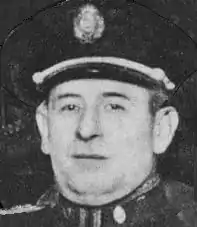
Brigadier General Juan Bautista Molina was an Argentine military commander and a pro-Nazi Argentine ultranationalist who led the Nationalist Liberation Alliance (ALN).[1][2][3]
Molina was involved in a number of plots to overthrow the Argentine liberal government of Agustín Pedro Justo in the 1930s.[4] In order to contain Molina, President Justo appointed Molina as Argentina's military attaché in Germany in 1933 where Molina witnessed the Nazi regime that impressed him.[5] Molina was promoted to brigadier general in 1937 and this was followed by his appointment as director general of the army engineers in 1938.[6] Molina retired from army service in 1938 and devoted attention to his leadership of the AJN.[7]
In 1935, Molina called for the dissolution of the three powers of the national government, the abolition of political parties, the establishment of a military dictatorship, the enacting of press censorship, and actions to prevent "immorality", and changing the economic system to be led by guilds and the creation of a "consultative board [to] unite" workers and employers.[8] In 1943, Molina led street demonstrations led by nationalist protestors against the Ramón Castillo government for its promotion of Argentine neutrality in World War II while Molina and his supporters were pro-Axis.[9] During the protest, Molina's supporters shouted violent anti-American, anti-British, and anti-Semitic slogans, saying "Death to the British pigs" and "Death to the Jews".[10]
References
- ↑ David Rock. Authoritarian Argentina: The Nationalist Movement, Its History and Its Impact. First paperback edition. Berkeley and Los Angeles, California, USA: University of California Press, 1995. Pp. 99, 133.
- ↑ Mark Alan Healey. The Ruins of the New Argentina: Peronism and the Remaking of San Juan After the 1944 Earthquake. Duke University Press, 2004. Pp. 319.
- ↑ United States State Department. Blue book on Argentina: consultation among the American republics with respect to the Argentine situation. Greenburg, 1946. Pp. 22.
- ↑ David Rock. Authoritarian Argentina: The Nationalist Movement, Its History and Its Impact. First paperback edition. Berkeley and Los Angeles, California, USA: University of California Press, 1995. Pp. 99.
- ↑ Sandra McGee Deutsch. Las Derechas: The Extreme Right in Argentina, Brazil, and Chile, 1890-1939. Stanford University Press, 1999. Pp. 240.
- ↑ Sandra McGee Deutsch. Las Derechas: The Extreme Right in Argentina, Brazil, and Chile, 1890-1939. Stanford University Press, 1999. Pp. 240.
- ↑ Sandra McGee Deutsch. Las Derechas: The Extreme Right in Argentina, Brazil, and Chile, 1890-1939. Stanford University Press, 1999. Pp. 240.
- ↑ David Rock. Authoritarian Argentina: The Nationalist Movement, Its History and Its Impact. First paperback edition. Berkeley and Los Angeles, California, USA: University of California Press, 1995. Pp. 103.
- ↑ David Rock. Authoritarian Argentina: The Nationalist Movement, Its History and Its Impact. First paperback edition. Berkeley and Los Angeles, California, USA: University of California Press, 1995. Pp. 103.
- ↑ David Rock. Authoritarian Argentina: The Nationalist Movement, Its History and Its Impact. First paperback edition. Berkeley and Los Angeles, California, USA: University of California Press, 1995. Pp. 103.